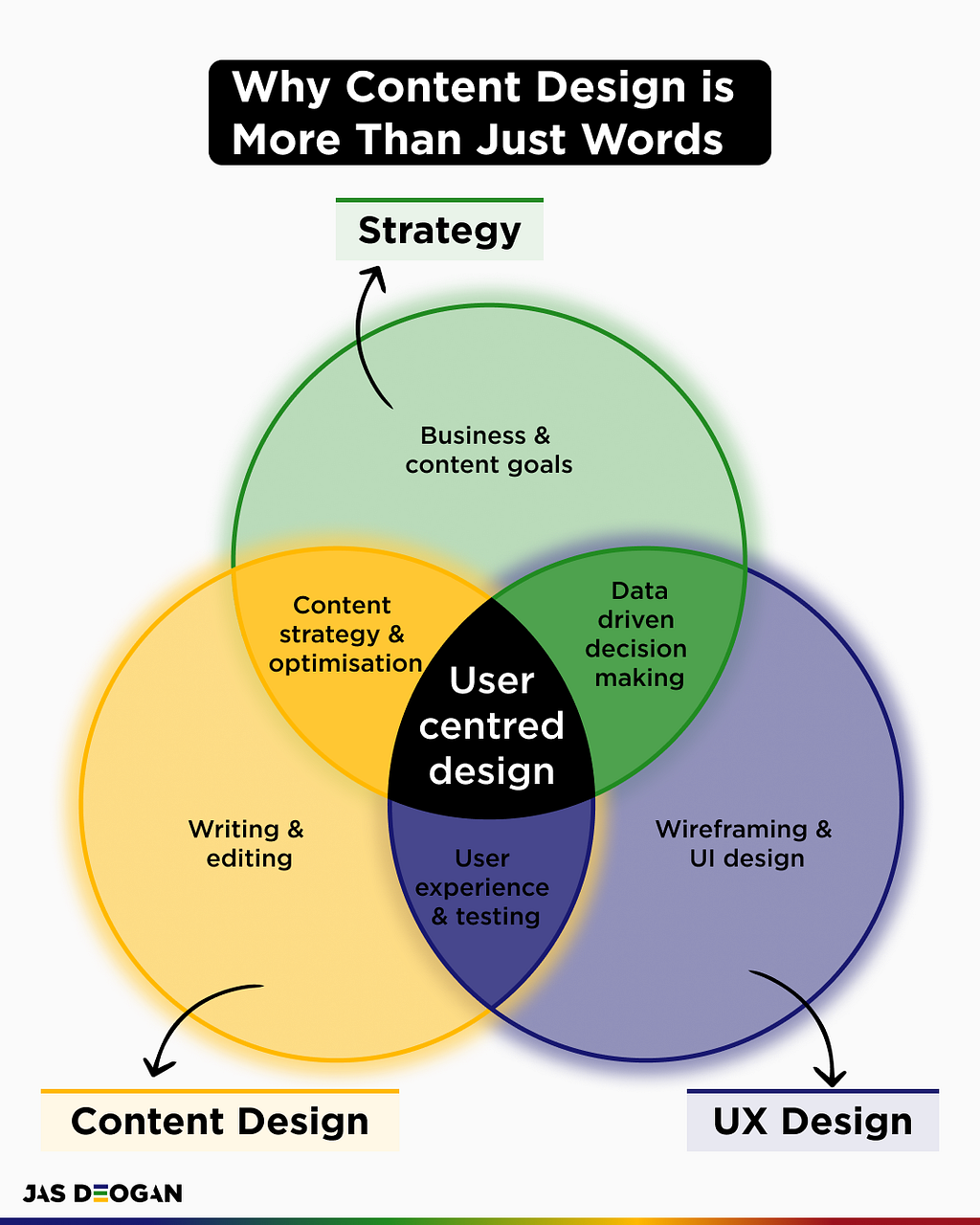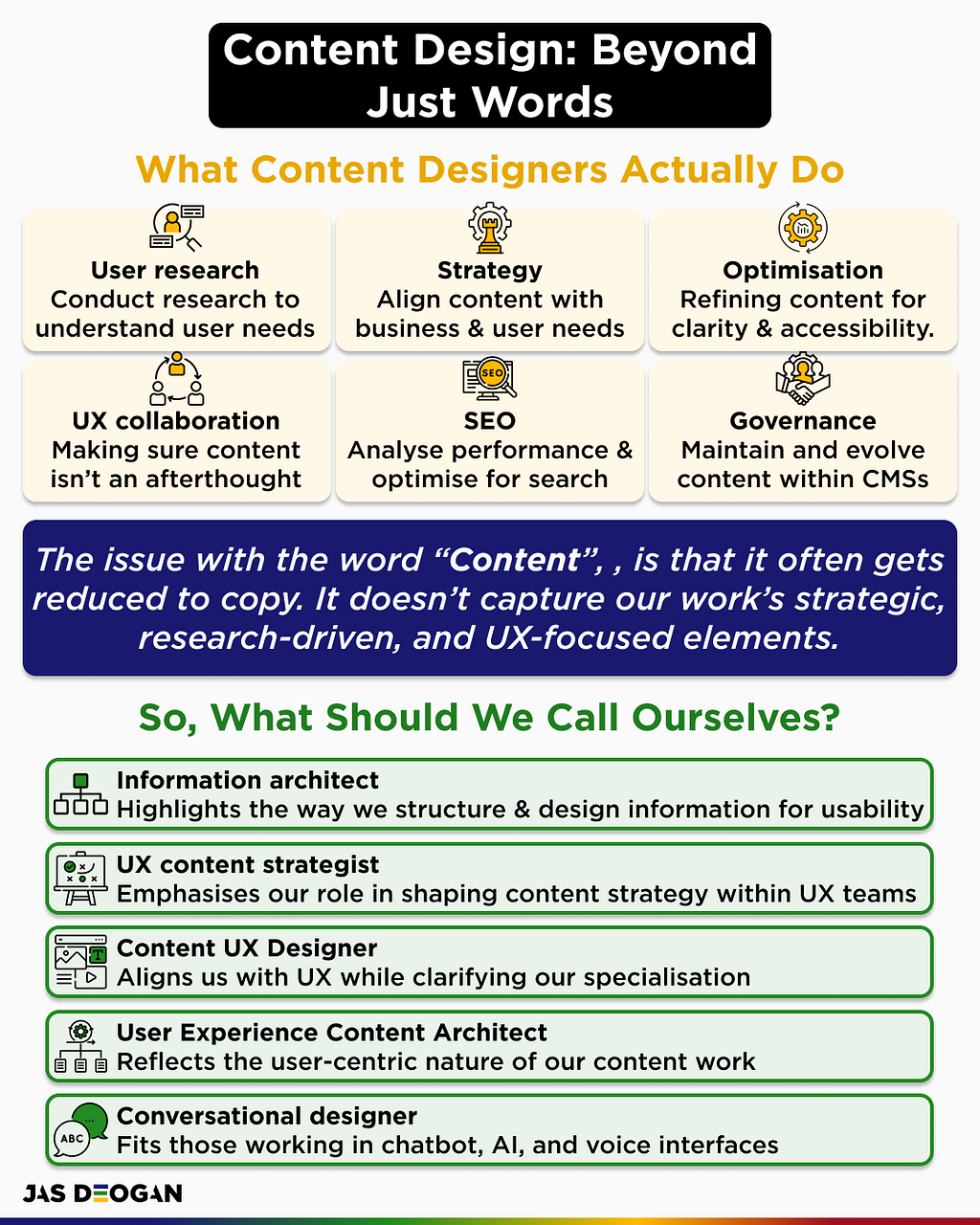
Close your eyes for a moment.
What comes to mind when you hear the term “Content Design?”
It’s words, right?
Well, you’re not wrong.
And if you’re like most people outside of the content design field, they’ll think the same.
It’s easy to see why, as when you hear the word ‘Content’, our first instinct is to associate it with the words we write and see.
However, this single focus limits our understanding of a craft that is essential to user experience (UX).
Why I think the term ‘Content Designers’ misses the mark
Very early on in my career, I was always baffled why my role, as a content manager, which is what I was called back then, sat within the e-commerce team.
UX, really, wasn’t a big priority as it is now, and I always felt that my role should sit within brand/marketing.
But. Things changed, and I grew.
And as UX took centre stage, I quickly realised that my role should align with user experience and product design.
However, as I started to adopt the term “Content Design,” I couldn’t help but notice that the term “Content Design” was a source of confusion.
I started noticing this more when I attended and hosted meet-ups. Often when people ask what I do, I say, “I’m a content designer.” I’d see a look of confusion strike their face. Curious about the role, they’d ask me more, which I’m more than happy to explain.
Lately, it’s got me wondering if the term “content designer” is undermining the role itself.
I think it’s fair to say that content designers and even other content professionals have always found themselves, sometimes unknowingly, in an ongoing battle to justify their work as more than just “wordsmithing.”
This understanding quickly and very effectively places unnecessary barriers on our opportunities to collaborate, influence, and lead in the design process.
Take, for instance, the well-established role of a UX Designer. Have we ever questioned their function?
No! Because it is widely acknowledged that UX design goes way beyond wireframing. Like content designers, UX designers help shape experiences, evoke emotions, and create simple, accessible user journeys.
Yet, content designers, who do much of the same work, continue to face scepticism. Despite our vital role in user-centred design, we are often perceived as post-design add-ons, consulted only when words need to be slotted into pre-existing designs.
This raises the question: Does the title “Content Designer” accurately reflect what we actually do?
What content designers actually do
Sorry to break the illusion, but we don’t just sit around “wordsmithing”.
Content Designers operate at the intersection of research, strategy, experience design, and communication. Here’s a snapshot of just some of what we actually do:
- User research
Conduct research to understand user needs, pain points, and behaviour, ensuring our content is relevant and effective. - Strategy
Define content goals, target audiences, and roadmaps to align with both business objectives and user needs. - Optimisation
Refine and optimise content for clarity and accessibility. - UX collaboration
Co-create with UX and UI designers, making sure that content isn’t an afterthought but an integral part of the user experience. - SEO
Analyse performance data, optimise for search engines, and iterate on content based on analytics. - Governance
Maintain and evolve content within content management systems (CMS) to ensure consistency and scalability. - User testing
Test our content with real users to refine and improve their interaction with digital experiences.
So then, if our work extends far beyond just writing, why is our title so limiting?

The problem with ‘Content’ in our title
Words are a powerful tool.
And the words we use to define our craft shape how others see it. The issue with the word “Content”, as alluded to before, is that it often gets reduced to copy. It doesn’t capture our work’s strategic, research-driven, and UX-focused elements.
Can you imagine if we called a UX Designer a “Wireframe Creator”
On the one hand, it would be funny and strange, but it wouldn’t accurately reflect their role. Yet “Content Designer” carries a similarly narrow connotation, making it easy for others to misunderstand or undervalue our contributions.
So, what should we call ourselves?
If “Content Designer” doesn’t fully capture what we do, then what alternative titles could?
As I’ve been part of many conversations discussing this topic, here are a few possibilities:
- Information Architect
Highlights the way we structure and design information for usability. It focuses on creating logical, user-friendly structures for content. It ensures that information is easily accessible, navigable, and understandable. - UX Content Strategist
Emphasises our role in shaping content strategy within UX teams. We define content goals and roadmaps aligned with user and business needs. As well as collaborating with designers and researchers to build user-centred narratives. - Content UX Designer
Aligns us with UX while clarifying our specialisation. We design user journeys with content as a core element, not an afterthought. We integrate content design seamlessly into wireframes and prototypes. - User Experience Content Architect
Reflects the user-centric nature of our content work. We build scalable content systems and frameworks for digital products. We balance strategy, structure, and tone to create holistic user experiences. - Conversational Designer
Suitable for those working in chatbots, AI, and voice interfaces. We design natural and intuitive conversational flows. We ensure tone, language, and structure meet both user needs and business goals.
Each of these alternative titles could expand the understanding of our work beyond just writing, helping to position us as core contributors to user experience and design.

But I don’t think changing a job title will single-handedly fix the problem.
It may help. But the real issue is awareness – helping teams and organisations understand the breadth of what we do.
When asked, “What is content design?” people normally get it and become even more curious when I explain what a content designer does.
A more accurate title can serve as a powerful starting point in reframing our role and cementing our value. However, we need to continue pushing for a shift in perception, not just in our title, but in how we discuss our work, which I’m starting to see more of.
As technology continues to advance, we should continue to explore titles that better represent our expertise, thereby commanding the respect our discipline deserves.
After all, we’re not just content designers. We are architects of experience, shapers of strategy, and creators of seamless, user-first digital interactions.
Enjoyed this?
Check out my other articles on design.
- AI is here. And it needs us
- Why no one takes content design seriously (and how to change that)
- The hero’s journey — The writing principles that guide users
- Accessibility. It’s a shared responsibility
I hope you enjoyed this article. If it was helpful, feel free to leave a clap or two, or consider dropping a comment. You can connect with me on LinkedIn and Medium. Also, feel free to check out my portfolio, too.
Is it time to rethink the title of content designer? was originally published in UX Planet on Medium, where people are continuing the conversation by highlighting and responding to this story.